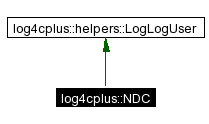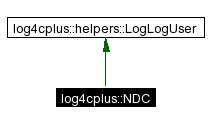
#include <ndc.h>
Inheritance diagram for log4cplus::NDC:


Public Member Functions | |
| void | clear () |
| Clear any nested diagnostic information if any. | |
| DiagnosticContextStack | cloneStack () |
| Clone the diagnostic context for the current thread. | |
| void | inherit (const DiagnosticContextStack &stack) |
| Inherit the diagnostic context of another thread. | |
| log4cplus::tstring | get () |
| Used when printing the diagnostic context. | |
| size_t | getDepth () |
| Get the current nesting depth of this diagnostic context. | |
| log4cplus::tstring | pop () |
| Clients should call this method before leaving a diagnostic context. | |
| log4cplus::tstring | peek () |
| Looks at the last diagnostic context at the top of this NDC without removing it. | |
| void | push (const log4cplus::tstring &message) |
| Push new diagnostic context information for the current thread. | |
| void | remove () |
| Remove the diagnostic context for this thread. | |
| void | setMaxDepth (size_t maxDepth) |
| Set maximum depth of this diagnostic context. | |
| ~NDC () | |
Friends | |
| LOG4CPLUS_EXPORT NDC & | getNDC () |
| Return a reference to the singleton object. | |
A Nested Diagnostic Context, or NDC in short, is an instrument to distinguish interleaved log output from different sources. Log output is typically interleaved when a server handles multiple clients near-simultaneously.
Interleaved log output can still be meaningful if each log entry from different contexts had a distinctive stamp. This is where NDCs come into play.
Note that NDCs are managed on a per thread basis. NDC operations such as push, pop, clear, getDepth and setMaxDepth affect the NDC of the current thread only. NDCs of other threads remain unaffected.
For example, a server can build a per client request NDC consisting the clients host name and other information contained in the the request. Cookies are another source of distinctive information. To build an NDC one uses the push operation. Simply put,
getNDC().push(). As a side effect, if there is no nested diagnostic context for the current thread, this method will create it.
getNDC().pop().
There is no penalty for forgetting to match each push operation with a corresponding pop, except the obvious mismatch between the real application context and the context set in the NDC. Use of the NDCContextCreator class can automate this process and make your code exception-safe.
If configured to do so, PatternLayout and TTCCLayout instances automatically retrieve the nested diagnostic context for the current thread without any user intervention. Hence, even if a server is serving multiple clients simultaneously, the logs emanating from the same code (belonging to the same logger) can still be distinguished because each client request will have a different NDC tag.
Heavy duty systems should call the remove method when leaving the run method of a thread. This ensures that the memory used by the thread can be freed.
A thread may inherit the nested diagnostic context of another (possibly parent) thread using the inherit method. A thread may obtain a copy of its NDC with the cloneStack method and pass the reference to any other thread, in particular to a child.
Definition at line 109 of file ndc.h.
|
|
|
|
|
Clear any nested diagnostic information if any. This method is useful in cases where the same thread can be potentially used over and over in different unrelated contexts.
This method is equivalent to calling the setMaxDepth method with a zero |
|
|
Clone the diagnostic context for the current thread. Internally a diagnostic context is represented as a stack. A given thread can supply the stack (i.e. diagnostic context) to a child thread so that the child can inherit the parent thread's diagnostic context. The child thread uses the inherit method to inherit the parent's diagnostic context.
|
|
|
Used when printing the diagnostic context.
Referenced by log4cplus::spi::InternalLoggingEvent::getNDC(). |
|
|
Get the current nesting depth of this diagnostic context.
|
|
|
Inherit the diagnostic context of another thread. The parent thread can obtain a reference to its diagnostic context using the cloneStack method. It should communicate this information to its child so that it may inherit the parent's diagnostic context. The parent's diagnostic context is cloned before being inherited. In other words, once inherited, the two diagnostic contexts can be managed independently.
|
|
|
Looks at the last diagnostic context at the top of this NDC without removing it. The returned value is the value that was pushed last. If no context is available, then the empty string "" is returned.
|
|
|
Clients should call this method before leaving a diagnostic context. The returned value is the value that was pushed last. If no context is available, then the empty string "" is returned.
Referenced by log4cplus::NDCContextCreator::~NDCContextCreator(). |
|
|
Push new diagnostic context information for the current thread.
The contents of the
Referenced by log4cplus::NDCContextCreator::NDCContextCreator(). |
|
|
Remove the diagnostic context for this thread. Each thread that created a diagnostic context by calling push should call this method before exiting. Otherwise, the memory used by the thread cannot be reclaimed. |
|
|
Set maximum depth of this diagnostic context.
If the current depth is smaller or equal to
This method is a convenient alternative to multiple pop calls. Moreover, it is often the case that at the end of complex call sequences, the depth of the NDC is unpredictable. The For example, the combination
|
|
|
Return a reference to the singleton object.
|
 1.3.2
1.3.2